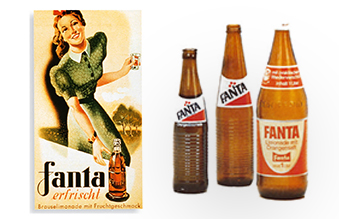Fanta: The Nazi Soft Drink That Has Stood The Test Of Time

Who loves orange soda? Kel loves orange soda!
Sorry did we say Kel? We meant the Nazis! The Nazis love orange soda!
Well, the Nazis, and all of 1930s and 40s Germany, loved soda. So much so that Coca-Cola continued to provide them with all of their Coca-Cola products throughout the 1930s- going as far as to sponsor the 1936 Berlin Olympics, where its famous Americana logo was positioned squarely next to a Swastika for the duration of the games. Even in 1939, when the Nazis began invading Europe, Coca-Cola happily provided soda for these genocidal maniacs.
Unfortunately for Coca-Cola, who consistently has no problem ignoring the human rights atrocities happening overseas (see: their reluctance last week to pull out of Russia over the Ukraine invasion) Germany had to go ahead and bomb Pearl Harbor- forcing all American companies to cease business with foreign enemies.
This became a problem for the Nazis. While Germans had no issue with their neighbors being hauled off to death camps by the millions, their sody pops were a whole other story. Luckily for the Germans, Coca-Cola still had a German Subsidiary, Coca-Cola GmbH. The only issue was that Coca-Cola could not export its top-secret formula to Coca-Cola GmbH from its Atlanta headquarters. The head of Coca-Cola GmbH, Nazi sympathizer Max Keith, had to get creative. Specifically, he had to get creative with fruit shavings, apple fibers, and beet sugar- as those were the only scraps he could get during war-time rationing. From these scraps came Fanta, which probably tasted gross and always different- as the formula changed based on what food materials Coca-Cola GmbH was able to get their hands on.

Still, Germans flocked to Fanta by the millions and the drink became a sign of nationalistic pride (as if the Germans needed another sign of nationalistic pride at this point.) Fanta was successful in reviving Coca-Cola’s European sales during the war, and Keith was promoted to head of Coca-Cola Europe once the war ended.
10 years later, in 1955, Coca-Cola reintroduced Fanta (which had previously been named after the German word for Fantasy) as a citrus beverage produced out of Naples, Italy. Today, Coca-Cola is reluctant to dive into Fanta’s history as the sugary fuel of Nazi Germany. However, in 2015, the company did attempt to bring back “Fanta Klassik” in Germany- using ads that drew upon the beverage’s history and promised Germans a “return to the good old days.”
The ads were pulled for stupidly obvious reasons.
Top Image: Coca-Cola Europacific Partners
Further Sources: Secret Formula: The Inside Story of How Coca-Cola Became the Best-Known Brand in the World, For God, Country, and Coca-Cola.





